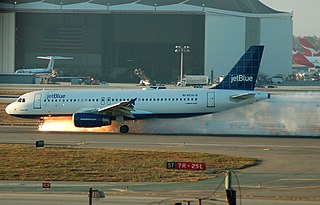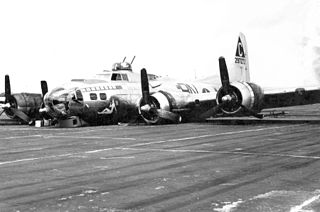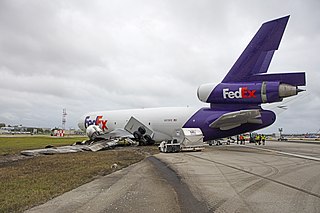
The Boeing 767 is an American wide-body aircraft developed and manufactured by Boeing Commercial Airplanes. The aircraft was launched as the 7X7 program on July 14, 1978, the prototype first flew on September 26, 1981, and it was certified on July 30, 1982. The initial 767-200 variant entered service on September 8, 1982, with United Airlines, and the extended-range 767-200ER in 1984. It was stretched into the 767-300 in October 1986, followed by the extended-range 767-300ER in 1988, the most popular variant. The 767-300F, a production freighter version, debuted in October 1995. It was stretched again into the 767-400ER from September 2000.

LOT Polish Airlines, legally incorporated as Polskie Linie Lotnicze LOT S.A., is the flag carrier of Poland. It is a founding member of IATA and remains one of the world's oldest airlines in operation. With a fleet of 75 aircraft as of 2023, LOT Polish Airlines is the 18th largest operator in Europe, serving 145 domestic and international destinations across Europe, Asia and North America. The airline was founded on 29 December 1928 by the Polish government during the Second Polish Republic as a self-governing limited liability corporation, taking over existing domestic airlines Aerolot and Aero, and began operations on 1 January 1929.

The McDonnell Douglas DC-10 is an American trijet wide-body aircraft manufactured by McDonnell Douglas. The DC-10 was intended to succeed the DC-8 for long-range flights. It first flew on August 29, 1970; it was introduced on August 5, 1971, by American Airlines.

Air Canada Flight 143, commonly known as the Gimli Glider, was a Canadian scheduled domestic passenger flight between Montreal and Edmonton that ran out of fuel on Saturday, July 23, 1983, at an altitude of 41,000 feet (12,500 m), midway through the flight. The flight crew successfully glided the Boeing 767 to an emergency landing at a former Royal Canadian Air Force base in Gimli, Manitoba, which had been converted to a racetrack, Gimli Motorsports Park. It resulted in no serious injuries to passengers or persons on the ground, and only minor damage to the aircraft. The aircraft was repaired and remained in service until its retirement in 2008. This unusual aviation incident earned the aircraft the nickname "Gimli Glider."

United Airlines Flight 232 was a regularly scheduled United Airlines flight from Stapleton International Airport in Denver to O'Hare International Airport in Chicago, continuing to Philadelphia International Airport. On July 19, 1989, the DC-10 serving the flight crash-landed at Sioux Gateway Airport in Sioux City, Iowa, after suffering a catastrophic failure of its tail-mounted engine due to an unnoticed manufacturing defect in the engine's fan disk, which resulted in the loss of many flight controls. Of the 296 passengers and crew on board, 112 died during the accident, while 184 people survived. 13 of the passengers were uninjured. It was the deadliest single-aircraft accident in the history of United Airlines.

Warsaw Chopin Airport is an international airport in the Włochy district of Warsaw, Poland. It is the busiest airport in Poland and the 31st busiest airport in Europe with 18.5 million passengers in 2023, handling approximately 40% of the country's total air passenger traffic. The airport is a central hub for LOT Polish Airlines as well as a base for Enter Air and Wizz Air.

Air China Flight 129 (CCA129/CA129) was a scheduled international passenger flight, operated by Air China, from Beijing Capital International Airport to Gimhae International Airport in Busan. On 15 April 2002, the aircraft on this route, a Boeing 767-200ER, crashed into a hill near the airport, killing 129 of the 166 people on board.
Chanchangi Airlines Nigeria Limited was a privately owned and operated airline with its head office in the Chanchangi Office Complex in Kaduna, Nigeria. It operates scheduled domestic passenger services. Its main base was Murtala Mohammed International Airport, Lagos, with hubs at Kaduna, Abuja, and Port Harcourt. Alhaji Ahmadu Chanchangi, its founder, hails from Chanchangi village in Takum Local Government of Taraba state, Nigeria.

An emergency landing is a premature landing made by an aircraft in response to an emergency involving an imminent or ongoing threat to the safety and operation of the aircraft, or involving a sudden need for a passenger or crew on board to terminate the flight. It typically involves a forced diversion to the nearest or most suitable airport or airbase, or an off airport landing or ditching if the flight cannot reach an airfield. Flights under air traffic control will be given priority over all other aircraft operations upon the declaration of the emergency.

A belly landing or gear-up landing occurs when an aircraft lands without its landing gear fully extended and uses its underside, or belly, as its primary landing device. Normally the term gear-up landing refers to incidents in which the pilot forgets to extend the landing gear, while belly landing refers to incidents where a mechanical malfunction prevents the pilot from extending the landing gear.
A foam path is the now-discouraged aviation safety practice of spreading a layer of fire suppression foam on an airport runway prior to an emergency landing. Originally, it was thought this would prevent fires, but the practice is no longer recommended.

TWA Flight 841 was a scheduled passenger flight from John F. Kennedy International Airport in New York City, en route to Minneapolis-Saint Paul International Airport in Minneapolis, Minnesota. On April 4, 1979, at or around 9:48 p.m. Eastern Standard Time, while flying over Saginaw, Michigan, the Boeing 727-31 airliner began a sharp, uncommanded roll to the right, and subsequently went into a spiral dive. The pilots were able to regain control of the aircraft and made a successful emergency landing at Detroit Metropolitan Airport.

LOT Polish Airlines Flight 007 was an Ilyushin Il-62 that crashed near Okęcie Airport in Warsaw, Poland, on 14 March 1980, as the crew aborted a landing and attempted to go-around. All 87 crew and passengers died. It was caused by the disintegration of one of the turbine discs in one of the plane's engines, leading to uncontained engine failure. The turbine disc was later found to have manufacturing faults.

LOT Polish Airlines Flight 5055 was a scheduled international passenger flight from Warsaw, Poland to New York City, the United States. In the late-morning hours of 9 May 1987, the Ilyushin Il-62M operating the flight crashed in the Kabaty Woods nature reserve on the outskirts of Warsaw around 56 minutes after departure. All 183 passengers and crew on board were killed in the crash, making it the deadliest accident involving an Ilyushin Il-62, and the deadliest aviation disaster in Polish history.
In aeronautics, loss of control (LOC) is the unintended departure of an aircraft from controlled flight and is a significant factor in several aviation accidents worldwide. In 2015 it was the leading cause of general aviation accidents. Loss of control may be the result of mechanical failure, external disturbances, aircraft upset conditions, or inappropriate crew actions or responses.

On October 28, 2016, FedEx Express Flight 910, a McDonnell Douglas MD-10-10F flying from Memphis International Airport to Fort Lauderdale–Hollywood International Airport was involved in a runway skid after a landing gear collapse, which resulted in a fire completely destroying the left engine and wing. Two crew members, the only people on board, were unharmed.

DHL de Guatemala Flight 7216 was an international cargo flight between Costa Rica's Juan Santamaría International Airport and Guatemala City's La Aurora International Airport. On 7 April 2022, the Boeing 757 operating the flight suffered a hydraulic failure, and crashed on landing at the Costa Rican airport. Neither of the two pilots were injured.
















